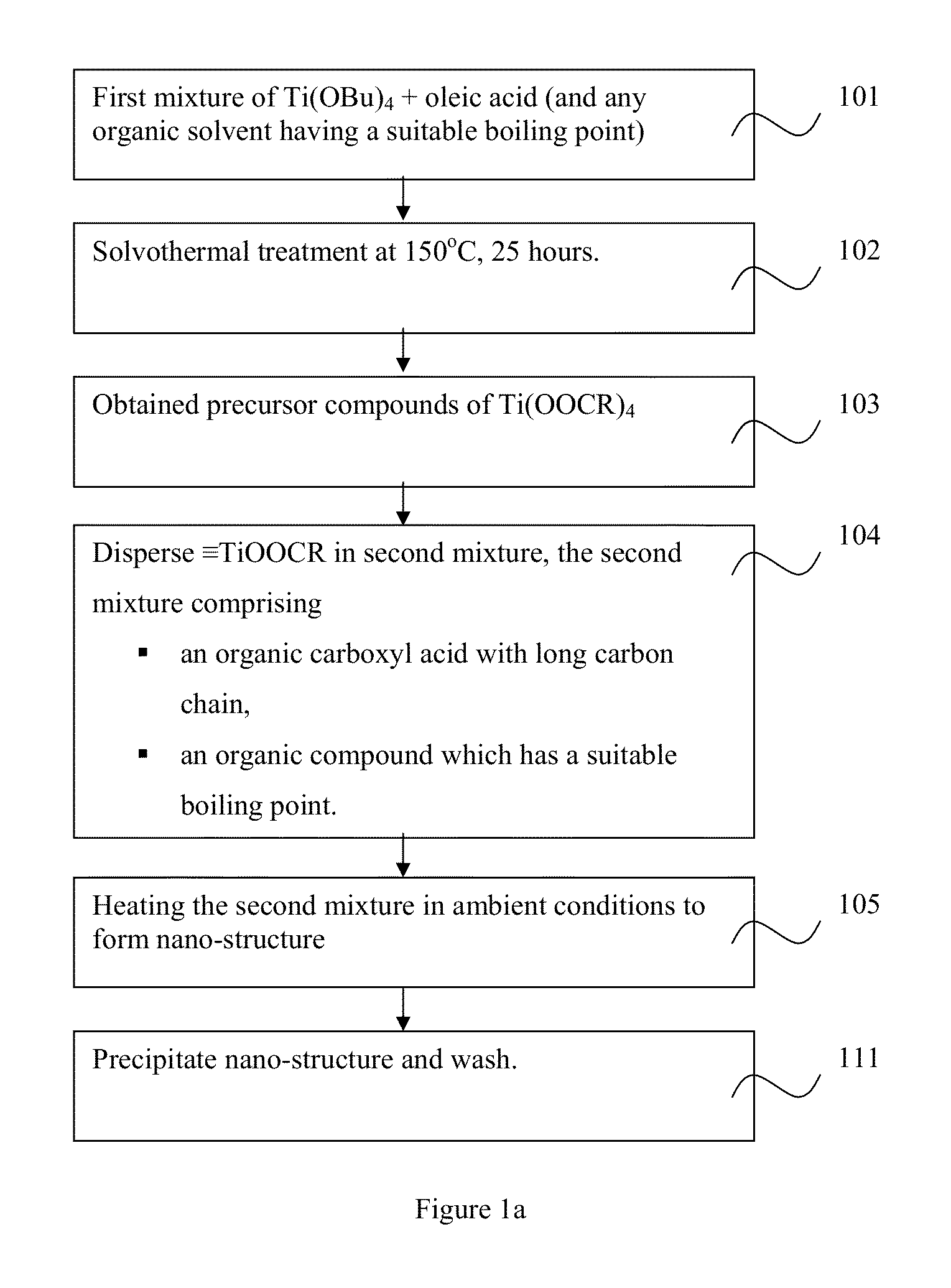Method for synthesising a nano-product
a nano-product and nano-technology, applied in the field of nano-products, can solve the problems of tedious methods, and achieve the effects of increasing the diameter of nano-products, increasing the temperature, and prolonging the period
- Summary
- Abstract
- Description
- Claims
- Application Information
AI Technical Summary
Benefits of technology
Problems solved by technology
Method used
Image
Examples
first embodiment
[0039]FIG. 1 and FIG. 1a are flowcharts of the invention, wherein anatase atomic wires are synthesised. The skilled reader knows that anatase is one of the mineral forms of titanium dioxide, TiO2.
[0040]In the first embodiment, 0.5 ml of titanium butoxide, Ti(OBu)4 where Bu refers to C4H9, is slowly added dropwise into a container holding a first mixture comprising 3 ml of oleic acid (C17H33COOH) and 10 ml of cyclohexane, at step 101.
[0041]The resulting solution is sealed in a Teflon-lined stainless autoclave, at step 101, and heated to 150° C. and for 25 hours in a solvothermal procedure. The autoclave provides the possibility of heating cyclohexane in the mixture to 150° C. to an elevated pressure, which otherwise has a boiling point of about 81° C. in ambient pressure. In this situation, the titanium butoxide is non-hydrolytically esterified and dimerised by ester-elimination, according to the following reactions:
[0042]
[0043]As illustrated in the chemical equations, the titanium b...
second embodiment
[0080]In a second embodiment, anatase TiO2 atomic wires is synthesised using a one-stage method, i.e. without a separate solvothermal treatment stage to prepare the titanium precursor complex separately. The embodiment is illustrated in the flowcharts of FIG. 10 and FIG. 10a.
[0081]0.5 ml of Ti(OBu)4 is slowly added dropwise, at step 201, into a mixture of 3.5 ml of oleic acid and 10 ml of 1-octadecene. The resulting solution is sealed in a three-neck-flask with stirring and heated to 150° C., and kept for 48 h in ambient conditions, at step 202. The use of autoclave is not included in this embodiment. The long period of reaction time permits the esterification reaction forming the titanium precursor complex and also the polycondensation reaction, at an elevated temperature, leading to the formation of the atomic wires to occur, without requiring a separate precipitation stage for the titanium precursor complex. That is, under an ambient pressure of 1 atmosphere, after the formation...
PUM
| Property | Measurement | Unit |
|---|---|---|
| diameter | aaaaa | aaaaa |
| temperature | aaaaa | aaaaa |
| temperature | aaaaa | aaaaa |
Abstract
Description
Claims
Application Information
 Login to View More
Login to View More - R&D
- Intellectual Property
- Life Sciences
- Materials
- Tech Scout
- Unparalleled Data Quality
- Higher Quality Content
- 60% Fewer Hallucinations
Browse by: Latest US Patents, China's latest patents, Technical Efficacy Thesaurus, Application Domain, Technology Topic, Popular Technical Reports.
© 2025 PatSnap. All rights reserved.Legal|Privacy policy|Modern Slavery Act Transparency Statement|Sitemap|About US| Contact US: help@patsnap.com



